#Blogaday 36/365
Thank you for joining me.
In case you have just joined me, know that you can access all of my earlier creations by checking under ‘categories’ on the right hand side of this blog under “Labels”. Then, for your convenience, follow me here or on Facebook, You Tube, Pinterest, Twitter or Instagram.
Check out all my social media handles at the bottom of this blog
Oh, and may I add that the fastest way to find any of my blogs is via Pinterest.
All my blogs can be printed. Find the printer friendly (green) link on the right side of this blog. You can also hit Control P (or Command P for Mac) on your keyboard, and the blog will go directly to the connected printer.
Remember that you only print if absolutely essential. Save paper – Save Our Earth.
Do remember to add my blog URL when you make and show off your creation.
Just copy the link on the search bar above - that's the blog URL.
To purchase this or similar yarn online, click here to buy your yarns online via Amazon. While you will still pay the same, I may get paid by Amazon as well.
This is a free blog - so do pay it forward for me. Cheers.
This has been a trying and difficult pattern to
write out.
Had I just made it for
myself, I think I’d have finished it a lot faster.. but I had to keep going
back to add a note ensuring that you are able to understand what I’m doing.
SO what we’ve ended up with is a long “wordsy” instruction sheet. That said, as I have taken all this trouble
to make it ‘easy’, I would really appreciate that when you make your
project you share my blog link.. and not just “Pattern from Sweet Nothings
Crochet”, but the actual URL.
After all, you have benefited from this
pattern, so let’s pay it forward and share it so someone else can too.
Edited after completion : Be warned that as
beautiful as this top is, it involves a lot calculation, free form work and
adjustments. I have winged it along a
lot on this one – as this project is made up of several little parts all joined
together to create this beauty.
While I do not wish to turn you off this
project, I will reiterate that this is not a project one can work on in front
of the TV, or without counting, or for the faint-hearted. It is an advanced
skill crochet project, and I do invite Intermediate crocheters who are willing
to take a plunge to jump hook-first in!
Materials used : Today I’ve
used just over 5 balls (50 gms each ball) of our
lovely Indian Anchor knitting cotton yarn with a 2.5 mm crochet hook ;
Optional : Stitch marker
For Indians : You can use our lovely Indian Red rose knittng cotton as well
General materials info : You can use any yarn with a suitable hook to make this project. May I suggest though, that the lighter yarns will give you a better end result.
For Non-Indians : I have used a regular knitting cotton that technically uses a 2 – 2.5 mm crochet hook (recommended). I use a larger hook as I like the extra stretch it affords the end product. Among the international yarns I have used in this thickness, I’d suggest Aunt Lydia Cotton 10, Aunt Lydia Bamboo-Viscose 10, DMC Petra, Sullivans knitting cotton (Australia), Milford Soft, Hilaza Rustica Eclat , Alize cotton yarn and Alize bamboo yarn.
Size
made : for 34” bust
Difficulty level
: Advanced Skill level
Abbreviations used : (Using U.S terminology)
lp(s) : Loop(s) hk : Hook
dc : Double crochet sp : Space
sl-st : Slip stitch ch : Chain
st(s) : Stitch(es)
yo : Yarn Over
Stitches used : (Using U.S terminology)
Single Crochet : Sc : yo, insert hk into st ; yo (2 lps on hk); yo, draw through both lps. One sc made. Check out the video at https://youtu.be/ghACqBpA-3k Half Double Crochet : Hdc : yo, insert hk into st ; yo (3 lps on hk) ;
yo, draw through all 3 lps. One hdc made.
Double crochet 4-tog as a decrease stitch : dc 4-tog : Here is an easy video tutorial for working a dc 4-tog
over 4 sts at
https://youtu.be/WjSNi7ithIU Double crochet 4-tog as a decorative stitch : dc 4-tog : Here is an easy video tutorial for working a dc 4-tog
all in the same stitch as a decorative stitch at
https://youtu.be/_B0-ye0cClU Double crochet 5-tog as a decrease stitch : dc 5-tog : Here is an easy video tutorial for working a dc 5-tog
over 5 sts at
https://youtu.be/Dh2viux_fBA Double crochet 5-tog as a decorative stitch : dc 5-tog : Here is an easy video tutorial for working a dc 5-tog
all in the same stitch as a decorative stitch at
https://youtu.be/5806EIpgcV8
Instructions using U.S terminology
Please note that I start all my rows with a ch 1, turning chain for ease.
Please check the top of this blog for easy video tutorials on all stitches used in today's pattern. For your convenience there video tutorials through the blog too
Please read through all my notes before you pick up your hook, so you know just where we're heading in our pattern.
In my patterns I work with the principle of stitch count and body measurement.
This means that you need to work the stitch count in pattern, till you get the measurement (length and/or width) that you need for your project.
Before we
start on our journey, as usual, let’s see what we’re going to do here. There are several elements in this top which
each seem to be made separately and then joined together. This does not look like its going to be an
easy one, so I’d appreciate your patience in reading through to see if we can
figure out just how to get this done. I’d also appreciate if you could follow
along with the charts attached. Cheers.
As before,
I would really appreciate that you share my blog link with the exact
page to go to, so that anyone else who wishes to make this can also enjoy this
free experience. Thanks in advance.
With most
of the patterns that I’ve worked on so far, there is usually a pattern stitch
count that allows one to increase the size of our project. This project, though, is made up of motifs
that are kind-of fixed sized – so to increase this project, I think you could
use a thicker yarn. Yes, the project
then looks bulkier – so the second idea I have is that you work the front and
back motifs in the same way (i.e same size), and then you increase the width of
Part 2 (Sides of the Front Motif).
This is
one that has me flummoxed for the increase – so if you do increase and get it
right, please could you add your ideas / notes on this blog and let me know
too.. so that we can help someone else along too. Cheers.
PART 1 :
CENTRE FRONT MOTIF
I am going
to start with the first motif that forms the central part of the yoke and we’ll
work outwards from here.
Start
Row 1 :
with 5
fsc. Turn.
In our
following row, we’ll use a Small Shell Stitch which is (2 dc ; ch 2, 2 dc) all
in the same st or ch-sp.
Double Crochet : dc : yo, insert hk into st ; yo (3 lps on hk); [yo, draw through 2 lps] twice. One dc made. Check out the video at https://youtu.be/xdnjB27zpYo
Row
2 :
Shell St
in the 1st fsc ; sk next 2 fsc, 3 dc in the next fsc ;
sk next 2
fsc, Shell St in the last fsc. Turn.
Row
3 :
Shell St
in the 1st Shell St ; ch 3,
sk next 3
dc, Shell St in the last Shell St. Turn.
Row
4 :
Shell St
in the 1st Shell St ;
ch 2, dc
in the next ch-3 sp ;
ch 2,
Shell St in the last Shell st. Turn.
Row
5 :
Shell St
in the 1st Shell St ;
ch 2, 3 dc
in the next dc ; ch 2, Shell St in the last Shell st. Turn.
Row
6 :
Shell St
in the 1st Shell St ;
[ch 2, dc
in the next dc ; 2 dc in the next dc ; dc in the next dc] ;
ch 2,
Shell St in the last Shell st. Turn.
Row
7 :
Shell St
in the 1st Shell St ;
[ch 2, 2
dc in the next dc ; dc in the next 2 dc] ;
ch 2,
Shell St in the last Shell st. Turn.
Row
8 :
Shell St
in the 1st Shell St ;
[ch 2, dc
in the next 5 dc] ;
ch 2,
Shell St in the last Shell st. Turn.
Row
9 :
Shell St
in the 1st Shell St ; ch 2, dc in the next dc ;
(ch 1, dc
in the next dc) ; rep (to) 3 times ;
ch 2,
Shell St in the last Shell st. Turn.
Row
10 :
Shell St
in the 1st Shell St ; ch 2, 2 dc in the next dc ;
(ch 1, 2
dc in the next dc) ; rep (to) 3 times ;
ch 2,
Shell St in the last Shell st. Turn.
Row
11 :
Shell St
in the 1st Shell St ;
ch 2, [2
dc in the next dc ; dc in the next dc] ;
(ch 1, rep
[to] once) ; rep (to) 3 times ;
ch 2,
Shell St in the last Shell st. Turn.
Row
12 :
Shell St
in the 1st Shell St ; ch 2, dc in the next 3 dc ;
[ch 1, dc
in the next 3 dc] ; (ch 1, 2 dc in the next dc) ;
rep (to) 2
times ; rep [to] 2 times ;
ch 2,
Shell St in the last Shell st. Turn.
Row
13 :
Shell St
in the 1st Shell St ; ch 2, dc in the next 3 dc ;
[ch 1, dc
in the next 3 dc] ;
{ch 1, dc
in the next 2 dc} ;
(ch 1, 2
dc in the next ch-1 sp) ; sk next 2 dc, rep (to) once ;
rep {to}
once ;
rep [to] 2
times ;
ch 2,
Shell St in the last Shell st. Turn.
In the
following row, we’re going to use a dc 6-tog.
Now I do not think there is any tutorial for a “how to” but if you can
work a dc 4 or 5-tog , you just do the same thing for the 6th dc,
and work them all in together.
Check the video links for dc 4-tog and dc 5-tog at the top of this blog
This will give us our first ‘petal’ on this yoke
motif.
Row
14 :
Shell St
in the 1st Shell St ;
ch 3, dc-6
tog over the next 6 dc ;
[ch 2, 2 dc
in the next dc ; dc in the next dc] ;
rep [to]
once ; ch 1, dc in the next ch-1 sp ;
(ch 1, dc
in the next dc ; 2 dc in the next dc) ;
ch 2, dc
in the next dc ; 2 dc in the next dc;
ch 2, dc-6
tog over the next 6 dc ;
ch 3,
Shell St in the last Shell st. Turn.
Row
15 :
{Shell St ;
ch 2 , 2 dc} all in the 1st Shell St ;
ch 2, sk dc-6
tog, dc in the next 3 dc ;
[ch 2, dc
in the next 3 dc] ;
ch 2, 2 dc
in the next dc ;
rep [to] 2
times ;
ch 2, sk
dc-6 tog, rep {to} once. Turn.
We have
effectively ‘split’ the Shell Stitch and will start a 2nd row of
Shell Stitches.
Row
16 :
Shell St
in the 1st ch-2 sp ;
ch 2, sk
next 2 dc, Shell St in the next ch-2 sp ;
[ch 2, dc
in the next 3 dc] ;
rep [to]
once ;
{ch 1, 2
dc in the next dc ; ch 1, dc in the next 2 dc} ;
rep [to] 2
times ;
ch 2, sk
next 2 dc, Shell St in the next ch-2 sp ;
ch 2, sk
next 2 dc, Shell St in the next ch-2 sp ; Turn.
Row
17 :
Shell St
in the 1st Shell St ;
{ch 3,
Shell St in the next Shell St} ;
[ch 1, dc
in the next 3 dc] ;
rep [to]
once ;
ch 2, 2 dc
in the next dc ; ch 1, dc in the next 2 dc ;
ch 2, dc
in the next 3 dc ;
rep [to] once
;
rep {to} 2
times. Turn.
In the
following row, we’ll once again end off our next set of petals with a dc 6-tog.
Row
18 :
Shell St
in the 1st Shell St ;
ch 5, {Shell
St in the next Shell St} ;
[ch 3, dc 6-tog
over the next 6 dc] ;
(ch 3, 2
dc in the next dc ; dc in the next dc) ;
ch 3, dc
in the next dc ; 2 dc in the next dc
rep [to]
once ;
ch 3, rep
{to} once ; ch 5, rep {to} once. Turn.
Row
19 :
Shell St
in the 1st Shell St ;
(ch 2, 3
dc in the next ch-5 sp) ;
ch 2, {Shell
St in the next Shell St} ;
[ch 3, sk dc
6-tog , dc in the next 3 dc] ;
ch 1, dc
in the next 3 dc ;
ch 3, sk
next dc 6-tog, rep {to} once ;
rep (to)
once ;
ch 2, rep
{to} once. Turn.
Row
20 :
Shell St
in the 1st Shell St ;
(ch 2, 2 dc
in the next dc ; dc in the next dc ; 2 dc in the next dc) ;
ch 2,
{Shell St in the next Shell St} ;
[ch 3, dc in
the next 6 dc] ;
ch 3,
{Shell St in the next Shell St} ;
rep (to)
once ;
ch 2, rep
{to} once. Turn.
Row
21 :
Shell St
in the 1st Shell St ;
ch 2, dc
in the next dc ;
(ch 1, dc
in the next dc) ; rep (to) 3 times ;
ch 2,
{Shell St in the next Shell St} ;
[ch 3, dc
6-tog over the next 6 dc] ;
ch 3,
{Shell St in the next Shell St} ;
ch 2, dc
in the next dc ;
rep (to) 4
times ;
ch 2, rep
{to} once. Turn.
Row
22 :
Shell St
in the 1st Shell St ;
ch 2, 2 dc
in the next dc ;
(ch 2, 2 dc
in the next dc) ; rep (to) 3 times ;
ch 3,
{Shell St in the next Shell St} ;
ch 1, sk
dc 6-tog, rep {to} once
ch 2, 2 dc
in the next dc ;
rep (to) 4
times ;
ch 2, rep
{to} once. Turn.
Row
23 :
Shell St
in the 1st Shell St ;
ch 2, 2 dc
in the next dc ; dc in the next dc ;
(ch 1, 2
dc in the next dc ; dc in the next dc) ;
rep (to) 3
times ;
ch 3, {2
dc in the next Shell St ; ch 2, 2 dc in the next shell st} ;
ch 3, 2 dc
in the next dc ; dc in the next dc ;
[ch 1, dc in the next dc ; 2 dc in the next
dc]
rep [to] 4
times ;
ch 2, Shell
St in the last Shell St. Turn.
Row
24 :
Shell St
in the 1st Shell St ;
ch 2, dc
in the next dc ;
(ch 1, dc
in the next dc) ;
rep (to) 13
times ;
ch 5, sk
next 4 dc & ch-2 sp , dc in the next dc ;
rep (to) 14
times ;
ch 2,
Shell St in the last Shell St. Turn.
Fasten off and weave in ends. We have
finished with the front centre motif.
We will
turn our work 90˚ and work along the side of this centre motif.
So I’ll suggest that you iron this bit out as we’re now going to work along the
sides (the Shell stitch sides) of the motif, one at a time, to create the
shoulder and sides of your top in Part 2.
So despite the fact that we’re working continuously, we will call this
Part 2 for convenience.
PART 2 :
SIDES OF THE FRONT & BACK MOTIF
As
mentioned before, we will turn our work 90˚ and work along the side of this
centre motif. Re-attach your yarn at the fsc bottom corner stitch and we will
work our way all the way to the top of the motif, corner Shell stitch, and then
we will carry on with a chain length that will make your shoulder. So what you now need to do is place this against
a well-fitting garment, and see how many inches you’ll need for the neckline to
shoulder, and you will work in that many chain.
For this
section, we will use this
chart
So how do
you decide where we’re working our stitches as we’re working along the sides? So each corner of the Shell st is where you
will work your sc ; and you will work 2 ch between one Shell st corner and the
next. Easy enough, right?
So on this
first row, I’m just going to say corner of shell st, and you know what I mean.
We will
work all the way from the bottom corner Shell stitch to the top shell stitch
for each side. So we’re going to work up
and down one side at a time.
Finally
our stitch count for this section is in multiples of 3 + 1.
Now for most part we have figured out how we will place our
stitches.
The stitch count is
important for the neck to shoulder section.
Row
1 :
sc in the
1st corner shell st ;
*ch 2, sc
in the next corner shell st* ;
rep *to*
all the way till the fsc st ;
add chain
in multiples of 3 + 1 till you reach the length needed for the portion from
neckline to shoulder. Turn.
In the
following row, please ensure that when you work the sc in the chain length,
ensure that you keep your stitch count.
Row
2 :
ch 1
(turning chain), dc in the 2nd ch the hk and in each ch till you
reach the 1st sc at the corner Shell st ;
* 2 dc in
the ch-2 sp ; dc in the next sc* ;
rep *to*
till end. Turn.
Row
3 :
dc in the
1st dc ;
*ch 2, sk
next 2 dc, dc in the next dc* ;
rep *to*
till end. Turn.
Row
4 :
dc in the 1st
dc ; ch 4, sk next ch-2 sp and dc, 4 dc in the next ch-2 sp ;
*ch 5, sk
next ch-2 sp, 4 dc in the next ch-2 sp* ;
rep *to*
till end. Turn.
Row
5 :
dc in the
1st dc ; ch 1, 2 dc in the same dc ;
*ch 2, sk
next 2 dc, sc in the space between the 2nd & 3rd dc ;
ch 2, (2
dc ; ch 2, 2 dc all in the next ch-5 sp)* ;
rep *to*
till last dc ; 2 dc ; ch 2, dc in the last dc.
Turn.
Row
6 :
dc in the
1st dc ; 2 dc in the 1st ch-1 sp ;
*ch 4, 5
dc in the next ch-2 sp* ;
rep *to*
till the last ch-1 sp ;
2 dc in
the last ch-1 sp ; dc in the last dc. Turn.
Row
7 :
sc in the
1st dc ;
*ch 2, (2
dc ; ch 2, 2 dc all in the next ch-5 sp) ;
ch 2, sk 2
dc, sc in the next dc* ;
rep *to*
till the last ch-5 sp ;
ch 2, sk 2
dc, sc in the last dc. Turn.
Triple Crochet : trc : wrap yarn twice around hook, insert hk into st ; yo (4 lps on hk); [yo, draw through 2 lps] three times. One trc made.
Row
8 :
trc in the
1st sc ; ch 3, 5 dc in the next ch-2 sp ;
*ch 5, sk
next 2 ch-2 sps, sc & 2 dc, 5 dc in the next ch-2 sp* ;
rep *to*
till the last ch-2 sp ; ch 3, trc in the last sc.
Row
9 :
dc in the
1st trc ; ch 1, 2 dc in the same trc ;
*ch 2, sk
next 2 dc , sc in the next dc ;
ch 2, sk
next 2 dc, (2 dc ; ch 2, 2 dc all in the next ch-5 sp)* ;
rep *to*
till the last trc ;
[2 dc ; ch 1, dc all in the last trc]. Turn.
Row
10 :
dc in the
1st dc ; 3 dc in the 1st ch-1 sp ;
*ch 3, sc
in the next sc ;
ch 3, sk next ch-2 sp and 2 dc, 5 dc in the next ch-2 sp* ;
rep *to* till last ch-1 sp ;
3 dc in
the last ch-1 sp ; dc in the last dc.
Turn.
I’m going
to keep the front aside at this point, and work on a similar back motif and
sides first – and then return to work on joining them both together. Bit like a jigsaw puzzle, ain’t it.. wonder
if the designer meant it like this.. hmmmm
PART 3 :
CENTRE BACK MOTIF
For the
back, we once again start with the centre back motif, and then work two sides
of the back, like we did the front.
Note
:
Even
before we start, notes ! I am starting with 11 fsc, and this will give us 3
pointed chevron ends. This started off
1.5” wide and the base width is 18”, with a height of about 15” down the bottom
of the flower tip . So if you want an
increase here, work in multiples as given below.
Start
:
with 11
fsc (or multiples of 3 + 2).
Row
1 :
dc in the
1st fsc ; ch 1, sk next fsc, dc in the next fsc ;
*ch 2, sk
2 fsc, dc in the next fsc* ;
rep *to* once
;
ch 1, sk
next fsc, dc in the last fsc. Turn.
Row
2 :
dc in the
1st dc ; ch 1, 2 dc in the next dc ;
*ch 2, 2
dc in the next dc* ;
rep *to* once
;
ch 1, dc
in the last dc. Turn.
Row
3 :
dc in the
1st dc ;
(ch 1, dc
in the next dc ; 2 dc in the next dc) ;
*ch
2, dc in the next dc ; 2 dc in the next
dc* ;
rep *to*
once ;
ch 1, dc
in the last dc. Turn.
Row
4 :
dc in the
1st dc ;
(ch 1, dc
in the next dc , 2 dc in the next dc ; dc in the next dc) ;
*ch
2, dc in the next dc ; 2 dc in the next
dc ; dc in the next dc* ;
rep *to*
once ;
ch 1, dc
in the last dc. Turn.
Row
5 :
dc in the
1st dc ;
(ch 1, dc
in the next 2 dc ; 2 dc in the next dc ; dc in the next dc) ;
*ch
2, dc in the next 2 dc ; 2 dc in the
next dc ; dc in the next dc* ;
rep *to*
once ;
ch 1, dc
in the last dc. Turn.
Row
6 :
dc in the
1st dc ;
(ch 1, dc
in the next 2 dc ; 2 dc in the next dc ; dc in the next 2 dc) ;
*ch
2, dc in the next 2 dc ; 2 dc in the
next dc ; dc in the next 2 dc* ;
rep *to*
once ;
ch 1, dc
in the last dc. Turn.
Row
7 :
dc in the
1st dc ;
(ch 1, dc
in the next 3 dc ; 2 dc in the next dc ; dc in the next 2 dc) ;
*ch
2, dc in the next 3 dc ; 2 dc in the
next dc ; dc in the next 2 dc* ;
rep *to*
once ;
ch 1, dc
in the last dc. Turn.
Row
8 :
dc in the
1st dc ;
(ch 1, dc
in the next 3 dc ; 2 dc in the next dc ; dc in the next 3 dc) ;
*ch
2, dc in the next 3 dc ; 2 dc in the
next dc ; dc in the next 3 dc* ;
rep *to*
once ;
ch 1, dc
in the last dc. Turn.
Row
9 :
dc in the
1st dc ;
(ch 1, dc
in the next 3 dc ; 2 dc in the next dc ; dc in the next 4 dc) ;
*ch
2, dc in the next 3 dc ; 2 dc in the
next dc ; dc in the next 4 dc* ;
rep *to*
once ;
ch 1, dc
in the last dc. Turn.
Row
10 :
dc in the
1st dc ;
(ch 1, dc
in the next 4 dc ; 2 dc in the next dc ; dc in the next 4 dc) ;
*ch
2, dc in the next 4 dc ; 2 dc in the
next dc ; dc in the next 4 dc* ;
rep *to*
once ;
ch 1, dc
in the last dc. Turn.
Row
11 :
dc in the
1st dc ;
(ch 1, dc
in the next 5 dc ; 2 dc in the next dc ; dc in the next 4 dc) ;
*ch
2, dc in the next 5 dc ; 2 dc in the
next dc ; dc in the next 4 dc* ;
rep *to*
once ;
ch 1, dc
in the last dc. Turn.
From the
following row, we’ll work in a Shell Stitch which is (3 dc ; ch 2, 3 dc in the
same ch-2 sp).
Please do
not confuse this with the earlier Shell Stitch for the Front motif.
Row
12 :
dc in the
1st dc ; 2 dc in the next ch-1 sp ; ch 2, 3 dc in the same
ch-1 sp ; *ch 7, sk next 11 dc, Shell Stitch in the next ch-2 sp* ;
rep *to*
once ;
ch 7, sk
next 11 dc, [3 dc ; ch 2, 2 dc in the last ch-1 sp] ; dc in the last dc. Turn.
Row
13 :
sl-st into
the 1st Shell Stitch ; Shell Stitch in the same Shell Stitch ;
*ch 4, dc
in the next ch-7 sp ; ch 4, Shell Stitch in the next ch-2 sp* ;
rep *to* till
end. Turn.
Row
14 :
sl-st into
the 1st Shell Stitch ; Shell Stitch in the same Shell Stitch
;
*ch 5, dc
in the next dc ; ch 5, Shell Stitch in the next Shell Stitch* ;
rep *to*
till end. Turn.
Row
15 :
sl-st into
the 1st Shell Stitch ; Shell Stitch in the same Shell Stitch
;
*ch 5, 3 dc
in the next dc ; ch 5, Shell Stitch in the next Shell Stitch* ;
rep *to*
till end. Turn.
Row
16 :
dc in the
1st 3 dc ;
*(2 dc in
the ch-2 sp ; ch 2, 2 dc in the same ch-2 sp ; dc in the next 3 dc ; 4
dc in the next ch-5 sp) ; ch 2, sk next dc, dc in the next dc ; ch 2, sk next
dc, 4 dc in the next ch-5 sp, dc in the next 3 dc* ;
rep *to*
till end. Turn.
Row
17 :
sl-st into
the 1st ch-2 sp ; Shell Stitch in the same ch-2 sp ;
*ch 4, sk
the next 6 dc ; (dc in the next 3 dc ; 2 dc in the next ch-2 sp ;
2 dc in
the next dc ; 2 dc in the next ch-2 sp) ; dc in the next 3 dc ;
ch 4, sk
the next 6 dc, Shell Stitch in the next ch-2 sp* ;
rep *to*
till end. Turn.
Row
18 :
sl-st into
the 1st Shell Stitch ;
(3 dc ; ch
3, 3 dc all in the same Shell Stitch) ;
*ch 5, sk
the next 2 dc ; dc in the next 8 dc ;
ch 5, sk
next 2 dc , rep (to) in the next Shell Stitch* ;
rep *to*
till end. Turn.
Row
19 :
sl-st in
the 1st 3 dc ;
*(5 dc ;
ch 2, 5 dc all in the next ch-2 sp) ; dc in the next 3 dc of Shell Stitch ;
[ch 5, sk
next 3 dc, dc in the next 2 dc ; ch 5, sk next 3 dc ; dc in the next 3 dc of
Shell Stitch* ;
rep *to*
till end. Turn.
Row 20 :
sl-st into
the 1st ch-2 sp ; Shell Stitch in the same ch-2 sp ;
*ch 2, sk
next 2 dc, dc in the next 6 dc ;
ch 4, sc
in the space between the next 2 dc ; ch 4 dc in the next 6 dc ;
ch 2, sk
next 2 dc, Shell Stitch in the next ch-2 sp* ;
rep *to*
till end. Turn.
Row
21 :
dc in the
1st 3 dc of Shell st ;
*(3 dc ;
ch 2, 3 dc all in the next ch-2 sp) ; dc in the next 3 dc of Shell st ; ch 2,
dc in the next dc ; ch 2, sk next dc, dc in the next 4 dc ; ch 5, sk sc, dc in
the next 4 dc ; ch 2, sk next dc, dc in the next dc ; dc in the next 3 dc* ;
rep *to*
till end. Turn.
For the
next part of this motif, I’m going to try and add one part of our earlier Front
Floral motif.
Row
22 :
sl-st into
the 1st ch-2 sp ; Shell St in the same 1st ch-2 sp
;
*ch 2, sk
next 4 dc, dc in the next 2 dc ;
(ch 4, sk
next 2 ch-sps & dc, dc in the next dc) ;
ch 3, sk
next 3 dc, 3 dc in the next ch-5 sp ;
ch 3, sk
next 3 dc, dc in the next dc ;
[ch 4, sk
next 2 ch-sps & dc, dc in the next 2 dc] ;
ch 2, sk
next 4 dc, Shell St in the next ch-2 sp* ;
rep *to*
till last ch-2 sp. Turn.
This next
row gets a little complicated (huh! Like it wasn’t earlier? ;) ) Please pay
attention to the ch-3 and ch-4 sps instructions.
Row
23 :
Shell St
in the 1st Shell St ;
*ch 4, sk
next ch-2 sp & 2 dc, sc in the next ch-4 sp ;
ch 4, sk
next dc, 2 dc in each of the next
3 dc ;
ch 4, sk
next dc, sc in the next ch-4 sp ; ch 4, Shell St in the next Shell St* ;
rep *to*
till end. Turn.
Row
24 :
Shell St
in the 1st Shell St ;
*ch 4, sc
in the next sc ;
ch 4, (2
dc in the each of the next 2 dc ; dc in the next 2 dc ;
2 dc in
the each of the next 2 dc) ;
ch 4, sc
in the next sc ; ch 4, Shell St in the next Shell St* ;
rep *to*
till end. Turn.
Row
25 :
Shell St
in the 1st Shell St ;
*ch 5, sk sc
, (dc in the next dc ; 2 dc in the each of the next 2 dc ;
dc in the
next dc) ; dc in the next 2 dc ; rep (to) once ;
ch 5, sk sc
, Shell St in the next Shell St* ;
rep *to*
till end. Turn.
Row
26 :
Shell St
in the 1st Shell St ;
*ch 5, dc
in the next 3 dc ; (ch 1, dc in the next 3 dc) ; ch 1, dc in the next 2 dc ;
rep (to) 2
times ;
ch 5,
Shell St in the next Shell St* ;
rep *to*
till end. Turn.
Row
27 :
Shell St
in the 1st Shell St ;
*ch 5, dc
in the next 3 dc ; (ch 1, dc in the next 3 dc) ;
[ch 1, 3 dc
in each of the next 2 dc] ;
rep (to) 2
times ;
ch 5,
Shell St in the next Shell St* ;
rep *to*
till end. Turn.
Row
28 :
sl-st into
the 1st Shell St ch-2 sp , 2 dc in the same ch-2 sp ;
(ch 2, 2
dc in the same ch-2 sp) ; rep (to) 2 times ;
*ch 3, [dc
in the next dc ; dc 2-tog over the next 2 dc] ;
ch 1, {dc
2-tog over the next 2 dc ; dc in the next dc} ;
ch 2 , 2 dc
in the next dc ;
ch 1, 2 dc
in the next dc ;
ch 1, dc
in the next 2 dc ;
ch 1, 2 dc
in the next 2 dc ;
ch 2, rep
[to] once ;
ch 1, rep
{to} once ;
ch 3, 2 dc
in the next ch-2 sp of the next Shell st ;
rep (to) 3
times* ;
rep *to*
till end. Turn.
In the
following row, we’ll use a dc 4-tog to finish off one flower petal.
Row
29 :
sl-st into
the 1st ch-3 sp , 2 dc in the same ch-3 sp ;
ch 3, 2 dc
in the same ch-3 sp ;
(ch 3, 2
dc in the next ch-3 sp ; ch 3, 2 dc in the same ch-3 sp) ;
rep (to) once
;
*ch 3, {dc
4-tog over the next 4 dc} ;
ch 3, [dc
in the next dc ; 2 dc in the next dc] ;
rep [to] once
;
dc in the
next 2 dc ;
rep [to] 2
times ;
ch 3, rep
{to} once ;
rep (to) 3
times. Turn.
Row 30 :
sl-st into
the 1st ch-3 sp , 2 dc in the same ch-3 sp ;
ch 3, 2 dc
in the same ch-3 sp ;
(ch 3, 2
dc in the next ch-3 sp ; ch 3, 2 dc in the same ch-3 sp) ;
rep (to)
once ;
*ch 3, sk
next dc 4-tog, dc in the next 3 dc ;
[ch 1, dc
in the next 3 dc] ;
ch 2, dc
in the next 2 dc ; ch 2, dc in the next 3 dc ;
rep [to]
once ;
sk dc
4-tog, rep (to) 3 times* ;
rep *to*
till end. Turn.
Row
31 :
sl-st into
the 1st ch-3 sp , 2 dc in the same ch-3 sp ;
ch 3, 2 dc
in the same ch-3 sp ;
(ch 3, 2
dc in the next ch-3 sp ; ch 3, 2 dc in the same ch-3 sp) ;
rep (to)
once ;
*ch 3, dc
in the next 3 dc ;
[ch 1, dc
in the next 3 dc] ;
ch 2, 2 dc
in the next 2 dc ; ch 2, dc in the next 3 dc ;
rep [to]
once ;
rep (to) 3
times* ;
rep *to*
till end. Turn.
Row
32 :
sl-st into
the 1st ch-3 sp , 2 dc in the same ch-3 sp ;
ch 3, 2 dc
in the same ch-3 sp ;
(ch , 2 dc
in the next ch-3 sp ; ch 3, 2 dc in the same ch-3 sp) ;
rep (to)
once ;
*ch 4, {dc
in the next dc ; dc 2-tog over the next 2 dc} ;
ch 1, rep
{to} once ;
< ch 3, dc in the next dc ; 2
dc in the next dc > ;
ch 1, rep < to > once
;
rep (to) 3
times* ;
rep *to* till
end. Turn.
Row
33 :
sl-st into
the 1st ch-3 sp , 2 dc in the same ch-3 sp ;
ch 3, 2 dc
in the same ch-3 sp ;
(ch 3, 2
dc in the next ch-3 sp ; ch 3, 2 dc in the same ch-3 sp) ;
rep (to)
once ;
*ch 4, dc
4-tog over the next 4 dc ; dc in the next 3 dc ; ch 1, dc in the next 3 dc ; ch
4, dc 4-tog over the next 4 dc ;
ch 4, 2 dc
in the next ch-3 sp ; ch 3, 2 dc in the same ch-3 sp ;
rep (to) 2
times* ;
rep *to*
till end. Turn.
From this
row on, we’re only going to work on the flower petals.. so we will be basically
skipping through all the Shell stitches.
To sk, rather than tediously sl-st all through, I have opted to work a
(sc ; ch 3, sk sts, sc in next st).
Now we’re
all advanced crocheters here.. so I am
just going to say sk through till… and I know that you will understand that we
need to work a ch-3 set all the way till where we need to be.
OR you
could fasten off and then re-attach your yarn in the dc after the dc 4-tog.
Cheers.
Row
34 :
[sc in the
1st dc ; and ch-3, sk sts and
sc in the next st all the way till the dc after the dc 4-tog]
dc in the
next 3 dc ; ch 1, dc in the next 3 dc ; Turn.
We will work
on and finish this one flower before going on to the next flower.
Row
35 :
dc in the
next 3 dc ; ch 1, dc in the next 3 dc ; Turn.
Row
36 :
dc in the
1st dc ; dc 2-tog over the next 2 dc ; dc 2-tog over the next 2 dc ;
dc in the last dc. Turn.
Row 37:
dc 4-tog
over all 4 dc. Fasten off and weave in ends.
Rep Rows
33 – 36 for the next set of flowers as well.
Fasten off and weave in ends.
PART 4 : BACK (SIDES)
For the
back, we once again repeat of Part 2 – Sides of the front motif.
The only
thing that you need to remember here is that with the front motif, we started
with a smaller base and worked up to a wider top , but with the back motif,
we’ve worked exactly opposite. So we now
have a pretty wide lower portion.
See how
many inches have been added onto the front with the side Part 2 and then decide
where you want to start and end this for this section.
Yes, a lot
of guess work.. but hey! You’ve come this far and worked it through.. so plod
on.. we’ll get through it.
I’ve
basically placed my back portion on top of the front yoke portion, and then worked
out where I need to start and end the side motifs.
I’ve
tapered off some of the pattern towards the bottom sides, to give it a shape
and take the pattern as far down as I could..
A bit of
free form here too.. as you can see… but hey, we’re learning something new.
Once we’re
done with this, we will join the shoulders and then work the sides.
There is this chart that I found as well, just in case you want to make a different pattern for the back, here goes
PART 5 : NECKLINE
SIDES
Yet again,
I’ll suggest you iron out the front and back portions you’ve made and place
them one on the other to see what we need to work on for the back neckline.
The
neckline bit is going to be a little tricky for the back.
For the front, you just ran a length of chain off the end of your work, and it
panned out OK. Here though, we’ve worked
top to bottom and we’ve got our back width worked out.
So what
I’ve done is now work the Part 2 pattern from the neckline end and attach on to
the back (sides) part that we’ve just worked on. We are mirroring the front
neck section, but in a different way.
PART 6 :
FINISHING
For the
final part, I’ve gone totally free form.
For
the sides :
So first
I’ve joined up my shoulders, and marked the armhole opening out. I’ve then basically worked the 1st
3 row of Part 2 (Sides) – first working an sc and ch-sp all across the side of
work ; then worked dc as we did before, and finally Row 3 which is the (dc ; ch
2, sk 2 dc, dc in the next dc). I’ve
then worked just Rows 2 & 3 to finish off the sides. Once done, join sides.
For
the neckline :
I felt
that the neck was too low and a little loose, so I just ran a row of sc all
around and tightened it – finishing with a row of picot. I used a ch-3 picot which is (ch 3, sl-st in
the 3rd ch from hk) every other stitch.
For
the armhole :
I liked
the shelled finish, so I’ve left that as it is.
For
the front bottom sides & centre :
Now that
you’ve joined the back & front, you’ll see that the back is longer than the
front (as intended) – so there’s some more free form that we will work on
now. See the corner between the back and
front – and see the pattern we have going?
It’s all dc one row and all ch-sps one row. So we just start on that corner with a ch-5
sp, and join it to the front to back.
Each row we work in a row of dc, and end it joining back to front once
again. The following row, work a row of
ch-sps and join it front to back again.
I continued this till I reached the back length – but as you’ll see we
still have a little bit of a gap in the centre front. So once again, working
between the piece you’ve just worked and the centre front, work the two rows
again (i.e all dc ; all ch-sps) till your two rows meet at the centre front.
Fasten off. Weave and glue down all ends.
Enjoyed this ?? I sure did.. come back right
here for more freebie patterns
If you're visiting me here for the first time, and have liked the experience, do add me to your mailing list (for your convenience) , and all my future free patterns will come straight to your mail box.
I’d appreciate if you could credit my blog (and link the original pattern link) when you make your own creation. Thanks.
Have a great day and see you soon.
Here are some of my older creations. Have fun with these free patterns too
and a doll’s top..
and some bolero/jacket/vests that will look grand on a top..
I have a few girls dresses, and just in case you want a dekho at those free patterns … here you go
For cute hair embellishments and motifs check the links below.
..and some belts..
and here are a few skirt patterns that you can use your belt for..

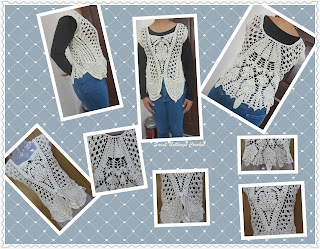
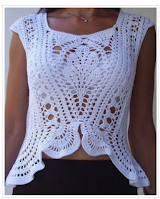


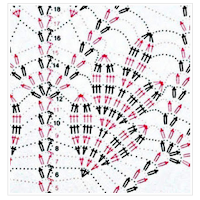
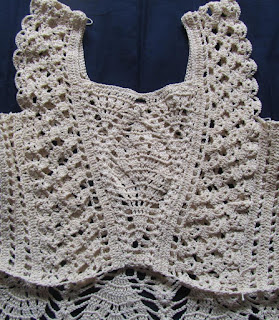

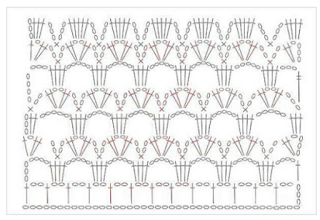

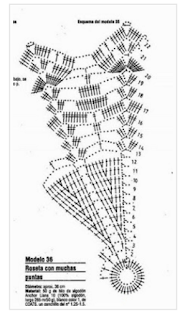

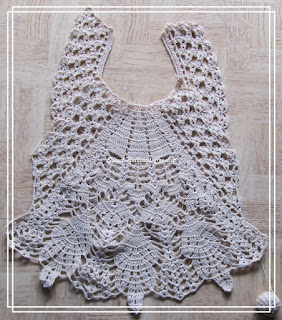



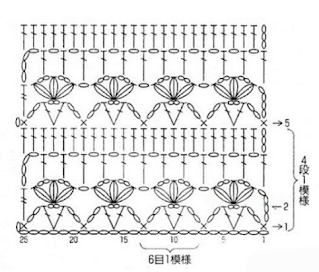









































No comments:
Post a Comment
Thanks for taking the time to stop by. Do tell me what you think. Cheers